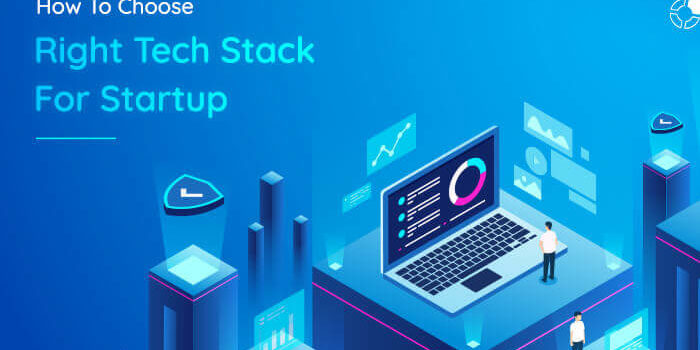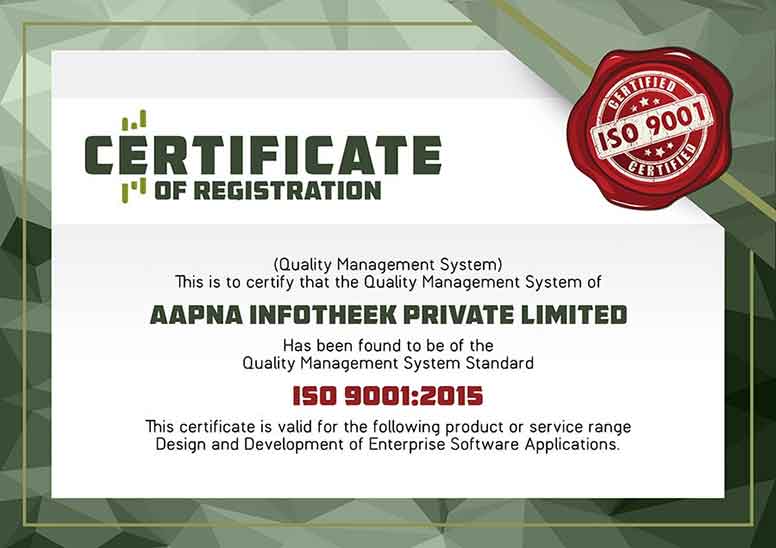Advanced technologies play a significant role in the success of any startup application. These days, a massive influx of technologies can confuse any modern startup, and choosing the right tech stack can quickly become overwhelming. Let’s find out how we can overcome the issues and make the right decision for choosing the best tech stack for startups!

Many startup owners fail to consider the important aspects of startup technology, and they think that only having a good-looking website or application will be enough to attract customers. But in reality, customers want to save time, so you should give them something that is fast, easy and efficient. For that, you will need to know the right tech stack for your startup.
What is Tech Stack
The tools needed to implement an IT idea are called Technology Stack or Tech Stack, which consists of development tools, libraries, frameworks, programming languages, and programming approaches themselves. For tech stack, the companies uses a correct combination of all these tools to determine the capability and competitiveness of an application that includes its scalability, maintenance, and functionality.
There are two parts of a tech stack:
- Client-side/Front-end: This part is responsible for providing a platform for the users to interact with the application’s back end. It contains everything that a user sees on their screen, and therefore the right tech stack will offer a convenient user experience, clear internal structures and an accessible user interface.The best tech stack for the front-end side of the application includes
- HTML
- CSS
- JavaScript
- UI-frameworks and libraries (Angular JS, React, React JS, jQuery, Node.js)
- Server-side/Back-end: In this part of the application, all the work is being done to store and manage data. It also gives a correct response to the users’ interaction on the client-side. The back-end stack needs to operate smoothly to enhance the overall experience of the application. The right tech stack for the back end side of the application will have the following:
- Programming Languages (JavaScript, PHP, Python
- Frameworks (Django, Ruby on Rails, Flask, etc.)
- Databases (MySQL and MongoDB)
- Server Providers (Nginx, Apache, etc.)
- Cloud infrastructures (Google Cloud, Microsoft Azure, AWS, etc.)
Phases of App Development Process
Before choosing the appropriate tech stack for your startup, you should know the phases involved in the startup app development process.
- Validation:
- Idea Validation: This phase determines whether your idea is appropriate for your potential customers or target audience. What will your app offer to the world, and is it scalable or not?
- Solution Validation: There are high chances that your app has multiple competitors, so in this phase, you will determine what features should be added to your minimum viable product that brings a unique solution to your target audience
- Software Development:
- Design: This is the most crucial phase of a startup app development; it begins with software design that determines the actual look of the end product. What elements will be on the main page, which buttons are used for which action, etc.
- Wireframing: After the product design is completed, then comes the wireframing stage. Here the software development team will connect the required features with the designed interface. In this stage, your team will basically create a wireframe that imitates the final product functionality.
- Front-end and back-end development: This phase is concerned with all the coding that goes into your app. It will operate the MVP features and exchanges data with the back end. It results in an interactive prototype used for testing.
- Testing: Alpha testing is usually done by an internal team or friends and family to verify MVP features and offers user feedback. It allows you to adjust according to the user’s perspective after that beta testing is performed, extended to a group of users to test the application against high workload.
- Releasing MVP: Once all the bugs are fixed, and additional features are added, MVP will be considered complete and ready for release. After the release, the development cycle continues with further updates or scaling the product by adding new features.
Things to Consider for Choosing a Tech Stack for Startups
- Startup Requirements and Features: First things first, you need to understand the different requirements and features of the startup. The two essential things that decide the selection of technologies are the size and purpose of any startup project. The larger the project is, the complex the tech stack will be.
- Small Projects: For small projects like a minimum viable product or single-page applications, well-established stacks like Node.js-React and Python-Django will be optimum.Examples:
- Test projects
- Alert apps
- Call recording applications, etc.
- Medium-sized Projects: Applications associated with medium-sized business like an online store requires intricate technical stacks consisting of multiple layers of frameworks and programming language.Examples:
- Local food delivery apps
- E-commerce apps
- Mid-market applications, etc.
- Large projects: Enterprise applications or complex marketplaces will require an even more complex and large technical stack to maintain the performance and integrity of the startup app. Such tech stacks are created in such a way that they are capable of performing a large number of data conditions. Therefore, they require several layers of frameworks and programming languages.Examples:
- Customer Relationship Management
- Enterprise Resource Planning
- Content Management System, etc.
Once you recognize the project type and its size, it is important to use only the necessary technologies without overloading the project with additional techniques.
- Small Projects: For small projects like a minimum viable product or single-page applications, well-established stacks like Node.js-React and Python-Django will be optimum.Examples:
- Experience and Resources: Before you choose your tech stack, it is essential to have adequate technical experience and knowledge. You need to know all the ins and outs and the differences between all the technologies available.Once you know which technologies are relevant for your project, you need to choose the ones you can work with confidently. Often, developers choose a technology just because it is new, and most of their time is spent on getting its insights and understanding it. So, it’s best to choose that you are most comfortable with, which isn’t too outdated or incompetent.
- Development Speed: Another crucial factor for choosing the best tech stack for startups is the speed of the project development. If the project needs to be developed in a short time, then it would be best to go for a ready-made tech stack solution that offers easy integration. The ready-made solutions for tech stack are the use of third-party integration to reduce the overall development time of the project.Here are some tech stack examples:
Name Tech Stack LAMP Stack Linux OS, Apache, My SQL, PHP MEAN Stack MongoDB, Express.js, Angular.js, Node.js MEVN Stack MongoDB, Express.js, Vue.js, Node.js MERN Stack MongoDB, Express.js, React.js, Node.js - Scalability: Your startup app must have an architecture that is scalable so that it can aid in its further development. A scalable application is the one that can handle the upcoming load and processes. When your users increase, your tech stack should be competent enough to allow the app to handle the growing users.Scalability is divided into two types:
- Vertical Scalability: Vertical scalability requires the app to be capable of adding new elements and features in the future.
- Horizontal Scalability: It requires the app to work on various devices and deal with an increasing number of users efficiently.
No matter how small or big, any application needs to have vertical and horizontal scalability to make the startup business successful. JavaScript is a powerful programming language with various libraries and structures that allow the application to be scalable.
- Maintainability: After making sure that your tech stack supports the requirement of scalability, you also need to consider the maintainability factor. Having maintainability in your app means that it can be maintained without any extra efforts when you scale.Maintainability depends on the following factors
- Codebase: The codebase must be of precise length, not too extensive or not too concise. Apps with lengthy codes require longer to process, whereas concise codes result in errors during debugging.
- Architecture: The architecture of the app should be scalable and mobile while supporting reusability.
- Security: The users of an application want to be sure that their personal information and data is secure. So, while you form your tech stack, don’t forget to choose those technologies that offer a great level of security for your startup app. If a startup app fails to bring safety to its users, it will create a negative reputation for the business, which is not great. The apps that offer online payment option are mostly in need of a secure framework.
Wrapping Up
Although there are many ready solutions available for the tech stack, they don’t always fulfil the project’s requirements. Therefore, choosing the best tech stack for startups is the key to any successful project, and it should be done by following a customized and effective approach.
Other Related Articles You Might Be Interested In
Top Fintech App Ideas for Startups
Everything You Need to Know to Build an MVP for Your Startups
How To Choose A Website Development Platform
8 Phases of the start up Life Cycle
If you have any questions and competent advice please connect with us









